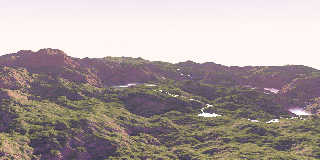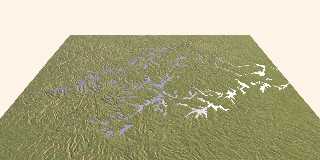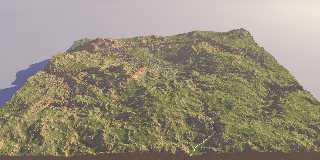 |
 |
|
 |
|
 |
|  |
|  |
|
 |
|
 |
|  |
|  |
|
 |
Ok, well, I cut way back on the number streams and finally got a finished
render. There's only 10 streams in this one.
Post a reply to this message
Attachments:
Download 'water3_03.jpg' (324 KB)
Preview of image 'water3_03.jpg'

|
 |
|  |
|  |
|
 |
|
 |
|  |
|  |
|
 |
On 16-2-2017 5:45, Kirk Andrews wrote:
> Ok, well, I cut way back on the number streams and finally got a finished
> render. There's only 10 streams in this one.
>
Like you said, with no provision for erosion, the streams here seem more
artificial then from above, running over the (lowest point) surface.
Nonetheless, it is impressive in my eyes! I am eager to experiment with
your code. I just downloaded it, thanks.
--
Thomas
Post a reply to this message
|
 |
|  |
|  |
|
 |
|
 |
|  |
|  |
|
 |
On 2/16/2017 4:36 AM, Kirk Andrews wrote:
> Stephen <mca### [at] aol com> wrote:
>
>> No, to get the water down you just need gravity. :-)
>> Seriously, Would you intend to make close ups or an animation? These
>> landscapes are generally quite static over short time spans. (I am sure
>> Thomas might have an opinion.)
>>
>
> I haven't played too much with animation, but suppose you could. It's not going
> to look too fantastic if you do a close up of those streams, since they're made
> of cones and spheres. You'd definitely be able to tell that up close.
>
> I've thought that maybe I could switch to building a mesh for the streams
> instead; that would probably yield better close-up potential.
>
> At the moment, it takes about half a second per stream to parse. There are about
> 100 streams in this render. If I don't have other settings cranked up too high,
> render times are just a few minutes right now.
>
They are good parsing times for something that looks complicated.
I only mentioned animation and close ups because you mentioned inertia.
Which made me think of the lakes draining. But for that I think you
would need to create the fluid dynamics in SDL or in a third party program.
--
Regards
Stephen com> wrote:
>
>> No, to get the water down you just need gravity. :-)
>> Seriously, Would you intend to make close ups or an animation? These
>> landscapes are generally quite static over short time spans. (I am sure
>> Thomas might have an opinion.)
>>
>
> I haven't played too much with animation, but suppose you could. It's not going
> to look too fantastic if you do a close up of those streams, since they're made
> of cones and spheres. You'd definitely be able to tell that up close.
>
> I've thought that maybe I could switch to building a mesh for the streams
> instead; that would probably yield better close-up potential.
>
> At the moment, it takes about half a second per stream to parse. There are about
> 100 streams in this render. If I don't have other settings cranked up too high,
> render times are just a few minutes right now.
>
They are good parsing times for something that looks complicated.
I only mentioned animation and close ups because you mentioned inertia.
Which made me think of the lakes draining. But for that I think you
would need to create the fluid dynamics in SDL or in a third party program.
--
Regards
Stephen
Post a reply to this message
|
 |
|  |
|  |
|
 |
|
 |
|  |
|  |
|
 |
Thomas de Groot <tho### [at] degroot org> wrote:
> On 16-2-2017 5:45, Kirk Andrews wrote:
> > Ok, well, I cut way back on the number streams and finally got a finished
> > render. There's only 10 streams in this one.
> >
>
> Like you said, with no provision for erosion, the streams here seem more
> artificial then from above, running over the (lowest point) surface.
> Nonetheless, it is impressive in my eyes! I am eager to experiment with
> your code. I just downloaded it, thanks.
>
> --
> Thomas
Looking forward to seeing what you can do with it!
Maybe you can help me figure out the bugs in my code. The lakes don't seem to be
filling up as much as they should, and I can't seem to figure out why. org> wrote:
> On 16-2-2017 5:45, Kirk Andrews wrote:
> > Ok, well, I cut way back on the number streams and finally got a finished
> > render. There's only 10 streams in this one.
> >
>
> Like you said, with no provision for erosion, the streams here seem more
> artificial then from above, running over the (lowest point) surface.
> Nonetheless, it is impressive in my eyes! I am eager to experiment with
> your code. I just downloaded it, thanks.
>
> --
> Thomas
Looking forward to seeing what you can do with it!
Maybe you can help me figure out the bugs in my code. The lakes don't seem to be
filling up as much as they should, and I can't seem to figure out why.
Post a reply to this message
|
 |
|  |
|  |
|
 |
|
 |
|  |
|  |
|
 |
"Kirk Andrews" <kir### [at] tektonart com> wrote:
> Thomas de Groot <tho### [at] degroot com> wrote:
> Thomas de Groot <tho### [at] degroot org> wrote:
> > On 16-2-2017 5:45, Kirk Andrews wrote:
> > > Ok, well, I cut way back on the number streams and finally got a finished
> > > render. There's only 10 streams in this one.
> > >
> >
> > Like you said, with no provision for erosion, the streams here seem more
> > artificial then from above, running over the (lowest point) surface.
> > Nonetheless, it is impressive in my eyes! I am eager to experiment with
> > your code. I just downloaded it, thanks.
> >
> > --
> > Thomas
>
> Looking forward to seeing what you can do with it!
>
> Maybe you can help me figure out the bugs in my code. The lakes don't seem to be
> filling up as much as they should, and I can't seem to figure out why.
I'm impressed. Downloaded the code. More impressed that you did this in 426
lines. Rendered and got to 81% in a couple of minutes. The big lake has slowed
things down and it was 22 minutes to finish. 3.0 GHz 4 core I5.
I see what you mean about the lakes not filling up enough to overflow and form a
follow on stream. I'm guessing Thomas will crack the problem before I do.
This is very nice work.
JimT org> wrote:
> > On 16-2-2017 5:45, Kirk Andrews wrote:
> > > Ok, well, I cut way back on the number streams and finally got a finished
> > > render. There's only 10 streams in this one.
> > >
> >
> > Like you said, with no provision for erosion, the streams here seem more
> > artificial then from above, running over the (lowest point) surface.
> > Nonetheless, it is impressive in my eyes! I am eager to experiment with
> > your code. I just downloaded it, thanks.
> >
> > --
> > Thomas
>
> Looking forward to seeing what you can do with it!
>
> Maybe you can help me figure out the bugs in my code. The lakes don't seem to be
> filling up as much as they should, and I can't seem to figure out why.
I'm impressed. Downloaded the code. More impressed that you did this in 426
lines. Rendered and got to 81% in a couple of minutes. The big lake has slowed
things down and it was 22 minutes to finish. 3.0 GHz 4 core I5.
I see what you mean about the lakes not filling up enough to overflow and form a
follow on stream. I'm guessing Thomas will crack the problem before I do.
This is very nice work.
JimT
Post a reply to this message
|
 |
|  |
|  |
|
 |
|
 |
|  |
|  |
|
 |
So, I'm starting to get my head around what's happening with the lakes not
filling up. As it searches for a point lower than the water level in an
increasing radius, it doesn't take into account whether or not the water can
actually flow that way.
So, for example, maybe the lake extends away to the north, beyond the current
testing radius, and there is a ridge to south, but then a lower point. Since the
lake extends away to the north, the algorithm detects that as the lowest point
(equal to the current water level), and therefore does not raise the water
level, but does keep expanding the radius. Eventually, it does detect a lower
point, but it's on the other side of the ridge. Right now, the algorithm has no
method to detect that the water can't get there from here, so it goes ahead and
jumps the stream through the rock to the other side.
Post a reply to this message
|
 |
|  |
|  |
|
 |
|
 |
|  |
|  |
|
 |
On 16-2-2017 18:28, JimT wrote:
> "Kirk Andrews" <kir### [at] tektonart com> wrote:
>> Thomas de Groot <tho### [at] degroot com> wrote:
>> Thomas de Groot <tho### [at] degroot org> wrote:
>>> On 16-2-2017 5:45, Kirk Andrews wrote:
>>>> Ok, well, I cut way back on the number streams and finally got a finished
>>>> render. There's only 10 streams in this one.
>>>>
>>>
>>> Like you said, with no provision for erosion, the streams here seem more
>>> artificial then from above, running over the (lowest point) surface.
>>> Nonetheless, it is impressive in my eyes! I am eager to experiment with
>>> your code. I just downloaded it, thanks.
>>>
>>> --
>>> Thomas
>>
>> Looking forward to seeing what you can do with it!
>>
>> Maybe you can help me figure out the bugs in my code. The lakes don't seem to be
>> filling up as much as they should, and I can't seem to figure out why.
>
> I'm impressed. Downloaded the code. More impressed that you did this in 426
> lines. Rendered and got to 81% in a couple of minutes. The big lake has slowed
> things down and it was 22 minutes to finish. 3.0 GHz 4 core I5.
My initial render was not finished after 4 hours, using 6 cores and i7.
Just switch to the defined 'WaterTex' texture and forget the one at the
end of the scene. The culprit probably is the finish. The whole image
now renders in a couple of minutes.
>
> I see what you mean about the lakes not filling up enough to overflow and form a
> follow on stream. I'm guessing Thomas will crack the problem before I do.
I am not that far yet... ;-)
>
> This is very nice work.
>
> JimT
>
>
>
--
Thomas org> wrote:
>>> On 16-2-2017 5:45, Kirk Andrews wrote:
>>>> Ok, well, I cut way back on the number streams and finally got a finished
>>>> render. There's only 10 streams in this one.
>>>>
>>>
>>> Like you said, with no provision for erosion, the streams here seem more
>>> artificial then from above, running over the (lowest point) surface.
>>> Nonetheless, it is impressive in my eyes! I am eager to experiment with
>>> your code. I just downloaded it, thanks.
>>>
>>> --
>>> Thomas
>>
>> Looking forward to seeing what you can do with it!
>>
>> Maybe you can help me figure out the bugs in my code. The lakes don't seem to be
>> filling up as much as they should, and I can't seem to figure out why.
>
> I'm impressed. Downloaded the code. More impressed that you did this in 426
> lines. Rendered and got to 81% in a couple of minutes. The big lake has slowed
> things down and it was 22 minutes to finish. 3.0 GHz 4 core I5.
My initial render was not finished after 4 hours, using 6 cores and i7.
Just switch to the defined 'WaterTex' texture and forget the one at the
end of the scene. The culprit probably is the finish. The whole image
now renders in a couple of minutes.
>
> I see what you mean about the lakes not filling up enough to overflow and form a
> follow on stream. I'm guessing Thomas will crack the problem before I do.
I am not that far yet... ;-)
>
> This is very nice work.
>
> JimT
>
>
>
--
Thomas
Post a reply to this message
|
 |
|  |
|  |
|
 |
|
 |
|  |
|  |
|
 |
On 16-2-2017 19:59, Kirk Andrews wrote:
> So, I'm starting to get my head around what's happening with the lakes not
> filling up. As it searches for a point lower than the water level in an
> increasing radius, it doesn't take into account whether or not the water can
> actually flow that way.
>
> So, for example, maybe the lake extends away to the north, beyond the current
> testing radius, and there is a ridge to south, but then a lower point. Since the
> lake extends away to the north, the algorithm detects that as the lowest point
> (equal to the current water level), and therefore does not raise the water
> level, but does keep expanding the radius. Eventually, it does detect a lower
> point, but it's on the other side of the ridge. Right now, the algorithm has no
> method to detect that the water can't get there from here, so it goes ahead and
> jumps the stream through the rock to the other side.
>
>
Ah. That is a complication indeed.
--
Thomas
Post a reply to this message
|
 |
|  |
|  |
|
 |
|
 |
|  |
|  |
|
 |
On 16-2-2017 19:59, Kirk Andrews wrote:
> So, I'm starting to get my head around what's happening with the lakes not
> filling up. As it searches for a point lower than the water level in an
> increasing radius, it doesn't take into account whether or not the water can
> actually flow that way.
>
I used here a height_field where a drainage pattern has been eroded with
the help of a succession of different applications. As I expected, the
pattern is not perfect, with ridges barring the drainage courses in
several places. I have not yet found a single application that does the
job faultlessly.
However, the code does a good job I think in joining the lowermost areas.
--
Thomas
Post a reply to this message
Attachments:
Download 'ka_water3_test.png' (1066 KB)
Preview of image 'ka_water3_test.png'

|
 |
|  |
|  |
|
 |
|
 |
|  |
|  |
|
 |
In this particular example, the erosional process seems to have been
better. A pity I cannot reproduce exactly what I did to get there as I
was just messing around without paying to close attention to the
different steps.
--
Thomas
Post a reply to this message
Attachments:
Download 'ka_water3_test.jpg' (230 KB)
Preview of image 'ka_water3_test.jpg'

|
 |
|  |
|  |
|
 |
|
 |
|  |
|
 |




![]()